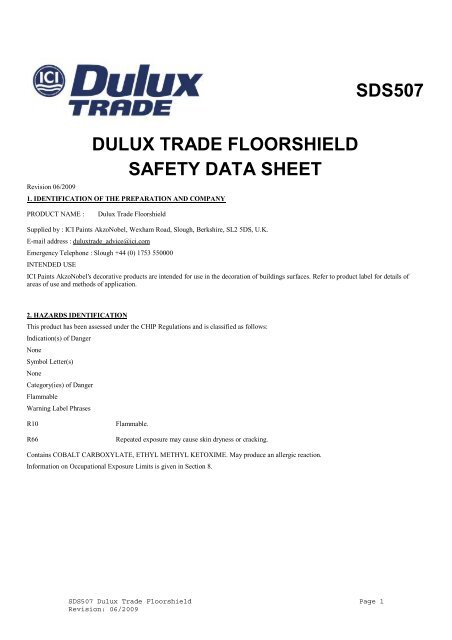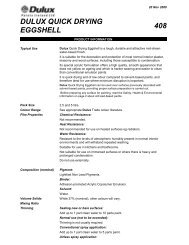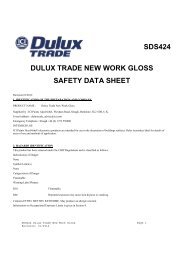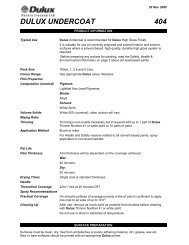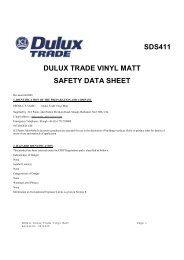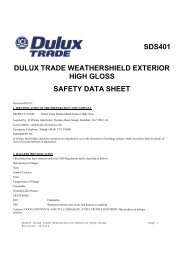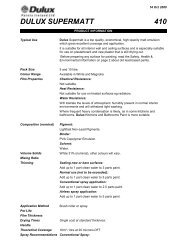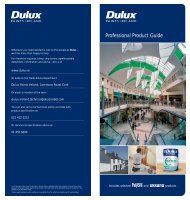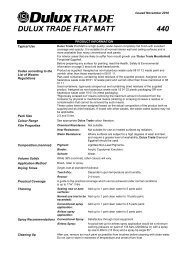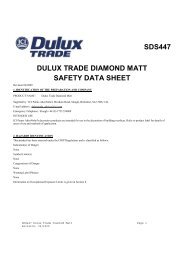Download PDF safety datasheet SDS507 for Dulux Trade Floorshield
Download PDF safety datasheet SDS507 for Dulux Trade Floorshield
Download PDF safety datasheet SDS507 for Dulux Trade Floorshield
Create successful ePaper yourself
Turn your PDF publications into a flip-book with our unique Google optimized e-Paper software.
<strong>SDS507</strong><br />
Revision 06/2009<br />
DULUX TRADE FLOORSHIELD<br />
SAFETY DATA SHEET<br />
1. IDENTIFICATION OF THE PREPARATION AND COMPANY<br />
PRODUCT NAME :<br />
<strong>Dulux</strong> <strong>Trade</strong> <strong>Floorshield</strong><br />
Supplied by : ICI Paints AkzoNobel, Wexham Road, Slough, Berkshire, SL2 5DS, U.K.<br />
E-mail address : duluxtrade_advice@ici.com<br />
Emergency Telephone : Slough +44 (0) 1753 550000<br />
INTENDED USE<br />
ICI Paints AkzoNobel's decorative products are intended <strong>for</strong> use in the decoration of buildings surfaces. Refer to product label <strong>for</strong> details of<br />
areas of use and methods of application.<br />
2. HAZARDS IDENTIFICATION<br />
This product has been assessed under the CHIP Regulations and is classified as follows:<br />
Indication(s) of Danger<br />
None<br />
Symbol Letter(s)<br />
None<br />
Category(ies) of Danger<br />
Flammable<br />
Warning Label Phrases<br />
R10<br />
R66<br />
Flammable.<br />
Repeated exposure may cause skin dryness or cracking.<br />
Contains COBALT CARBOXYLATE, ETHYL METHYL KETOXIME. May produce an allergic reaction.<br />
In<strong>for</strong>mation on Occupational Exposure Limits is given in Section 8.<br />
<strong>SDS507</strong> <strong>Dulux</strong> <strong>Trade</strong> <strong>Floorshield</strong> Page 1<br />
Revision: 06/2009
3. COMPOSITION/INFORMATION ON INGREDIENTS<br />
Substances presenting a physico-chemical, health or environmental hazard within the meaning of the CHIP Regulations or which are<br />
assigned occupational exposure limits.<br />
EC No. CAS No. HAZARDOUS INGREDIENTS % CLASSIFICATION<br />
265-150-3 64742-48-9 NAPHTHA (PETROLEUM),<br />
HYDROTREATED HEAVY<br />
25-50 Xn R10-65-66<br />
202-496-6 96-29-7 ETHYL METHYL KETOXIME < 1.0 Xn R21-40-41-43 Carc. Cat. 3<br />
270-066-5 68409-81-4 COBALT CARBOXYLATE < 1.0 N, Xn R22-38-43-51/53<br />
Note: The text <strong>for</strong> R phrase codes shown above (if any) is given in section 16.<br />
Note: 'EC Number' if quoted is the EINECS or ELINCS number.<br />
4. FIRST-AID MEASURES<br />
In all cases of doubt, or where symptoms persist, seek medical attention. Never give anything by mouth to an unconscious person.<br />
INHALATION: Remove to fresh air, keep patient warm and at rest. If breathing is irregular or stopped administer artificial respiration. Give<br />
nothing by mouth. If unconscious place in the recovery position. Seek medical advice.<br />
EYE CONTACT: Remove contact lenses. Irrigate copiously with clean, fresh water <strong>for</strong> at least 10 minutes, holding lids apart. Seek medical<br />
advice.<br />
SKIN CONTACT: Remove contaminated clothing, wash skin thoroughly with soap and water, or use a proprietary skin cleanser. Do not use<br />
solvents or thinners. Seek medical advice if symptoms persist.<br />
INGESTION: If accidentally swallowed, DO NOT INDUCE VOMITING. Keep at rest and obtain medical attention.<br />
5. FIRE-FIGHTING MEASURES<br />
Extinguishing media: Recommended - alcohol resistant foam, CO2, powders.<br />
Not to be used - waterjet.<br />
Recommendations : Fire will produce dense black smoke. Exposure to decomposition products may cause a health hazard.<br />
Fire fighters should wear self-contained breathing apparatus.<br />
Closed containers exposed to fire should be cooled with water. Do not allow run-off from fire-fighting to enter drains or water-courses.<br />
6. ACCIDENTAL RELEASE MEASURES<br />
Exclude non-essential personnel.<br />
Exclude sources of ignition and ventilate the area. Avoid breathing vapours. Refer to protective measures listed in section 8. Contain and collect<br />
spillage with non-combustible absorbent materials, eg sand, earth, vermiculite or diatomaceous earth, and place in container <strong>for</strong> disposal<br />
according to local regulations (see section 13). Do not allow to enter drains or watercourses. Clean preferably with a detergent; avoid use of<br />
solvents. If the product enters drains or sewers, immediately contact the local water company; in the case of contamination of streams, rivers or<br />
lakes, the relevant environment agency.<br />
<strong>SDS507</strong> <strong>Dulux</strong> <strong>Trade</strong> <strong>Floorshield</strong> Page 2<br />
Revision: 06/2009
7. HANDLING AND STORAGE<br />
Persons with a history of skin sensitisation problems which are related to substances listed in section 3 of this <strong>safety</strong> data sheet should only be<br />
employed in processes in which this product is used under appropriate medical supervision.<br />
HANDLING CONDITIONS: Vapours are heavier than air and may spread along floors. They may <strong>for</strong>m explosive mixtures with air. Prevent the<br />
creation of flammable or explosive concentrations of vapour in air and avoid vapour concentrations higher than the occupational exposure limits.<br />
In addition, the product should only be used in areas from which all naked lights and other sources of ignition have been excluded. Electrical<br />
equipment should be protected by the appropriate standard. Keep the container tightly closed. Exclude sources of heat, sparks and open flame.<br />
Non-sparking tools should be used. Avoid skin and eye contact. Avoid the inhalation of vapour and mist. Smoking, eating and drinking should be<br />
prohibited in storage and use areas. For personal protective equipment see Section 8. Always keep in containers made of the same material as the<br />
supply container, or in containers that are compatible with the product. The accumulation of contaminated rags may result in spontaneous<br />
combustion. Good housekeeping standards and regular safe removal of waste materials will minimise the risks of spontaneous combustion and<br />
other fire hazards.<br />
STORAGE CONDITIONS: Observe the label precautions. Store in a cool, dry, well ventilated place away from sources of heat, ignition and<br />
direct sunlight. No smoking. Prevent unauthorised access. Containers which are opened should be properly resealed and kept upright to prevent<br />
leakage. Do not use or store any paint container by hanging on a hook.<br />
The Manual Handling Operations Regulations 1993 may apply to the handling of certain Paint Products. Products packed in containers of 5 litres<br />
and above will be marked with a guide weight; refer to these weights when carrying out an assessment.<br />
For flash points between 21 and 32 degrees Celsius store in accordance with the Highly Flammable Liquids and Liquefied Petroleum Gas<br />
Regulations 1972.<br />
The principles contained in the HSE guidance note Storage of Packaged Dangerous Substances, should be observed when storing this product.<br />
Store separately from oxidising agents, strongly alkaline and strongly acidic materials, amines, alcohols and water.<br />
SPECIFIC USE(s): Where applicable refer to the product label and literature <strong>for</strong> the application and use instructions.<br />
8. EXPOSURE CONTROLS/PERSONAL PROTECTION<br />
EXPOSURE LIMIT VALUES<br />
HAZARDOUS INGREDIENT<br />
LTEL (8hr<br />
TWA) ppm<br />
LTEL (8hr<br />
TWA) mg/m3<br />
STEL (15<br />
mins) ppm<br />
STEL (15<br />
mins) mg/m3<br />
Notes<br />
NAPHTHA (PETROLEUM), HYDROTREATED<br />
HEAVY<br />
1000 OEL<br />
ETHYL METHYL KETOXIME 3 10 SUP<br />
COBALT CARBOXYLATE 0.1 WEL<br />
OEL - Occupational Exposure Limits<br />
WEL - Workplace Exposure Limit<br />
SUP - Manufacturer's recommended Limit<br />
LTEL - Long-term Exposure Limit.<br />
TWA - Time weighted Average<br />
STEL - Short term Exposure Limit (15mins)<br />
sk - Risk of absorption through unbroken skin<br />
sen - Respiratory sensitiser<br />
rd - Figure quoted is <strong>for</strong> Respirable dust<br />
id - Figure quoted is <strong>for</strong> Inhalable dust<br />
Further guidance on WELs and OELs, and on occupational exposure to harmful materials (including mixed exposures) is given<br />
in HSE Guidance Note EH40.<br />
EXPOSURE CONTROLS<br />
Be<strong>for</strong>e commencing work, ensure that a COSHH Assessment has been carried out. All personal protective equipment, including<br />
respiratory protective equipment, used to control exposure to hazardous substances must be selected to meet the requirements of<br />
local regulations.<br />
RESPIRATORY PROTECTION: Avoid the inhalation of vapour, particulates and spray mist. Where reasonably practicable, this<br />
should be achieved by the use of local exhaust ventilation and good general ventilation. If this is not sufficient to maintain<br />
concentrations of particulates and solvent vapour below the occupational exposure limit, respiratory protection must be worn.<br />
The selection of respiratory equipment should be in accordance with BS 4275. Recommendations <strong>for</strong> the selection, use and<br />
maintenance of Respiratory Equipment, and the current certificates of approval are issued annually by the Health and Safety<br />
Executive.<br />
<strong>SDS507</strong> <strong>Dulux</strong> <strong>Trade</strong> <strong>Floorshield</strong> Page 3<br />
Revision: 06/2009
HAND PROTECTION: Wear suitable gloves <strong>for</strong> protection against materials in section 3.<br />
When skin exposure may occur, advice should be sought from glove suppliers on appropriate types and usage times <strong>for</strong> this<br />
product. The instructions and in<strong>for</strong>mation provided by the glove supplier on use, storage, maintenance and replacement must be<br />
followed.<br />
EYE PROTECTION: Eye protection designed to protect against liquid splashes should be worn.<br />
SKIN PROTECTION: Cotton or cotton/synthetic overalls or coveralls are normally suitable. Grossly contaminated clothing<br />
should be removed and the skin washed with soap and water or a proprietary skin cleaner.<br />
FLATTING: Protective gloves should be worn to avoid the risk of skin irritation. When surfaces are to be prepared <strong>for</strong> painting,<br />
account should be taken of the age of the property and the possibility that lead pigmented paint might be present. There is a<br />
possibility that ingestion or inhalation of scrapings or dust arising from the preparation work could cause health effects As a<br />
working rule you should assume that this will be the case if the age of the property is pre 1960.<br />
Where possible wet flatting or chemical stripping methods should be used with surfaces of this type to avoid the creation of dust.<br />
When dry flatting cannot be avoided, and effective local exhaust ventilation is not available, it is recommended that a dust<br />
respirator is worn, that is approved <strong>for</strong> use with lead dusts, and its type selected on the basis of the occupational hygiene<br />
(COSHH) assessment, taking into account the occupational hygiene exposure standard <strong>for</strong> lead in air. Furthermore, steps should<br />
be taken to ensure containment of the dusts created, and that all practicable measures are taken to clean up thoroughly all<br />
deposits of dusts in and around the affected area.<br />
The Control of Lead at Work approved code of practice 1998 (ISBN 0 71 7615065) should be consulted <strong>for</strong> advice on protective<br />
clothing and personal hygiene precautions.<br />
Care should also be taken to exclude visitors, members of the household and especially children from the affected area, during<br />
the actual work and the subsequent clean up operations.<br />
All scrapings, dust, etc. should be disposed of by the professional painting contractor as Special (Hazardous) Waste, with the<br />
relevant documentation under The Special Waste Regulations 1996 plus amendment 2001, The Environmental Protection (Duty<br />
of Care) Regulations 1991, The Controlled Waste Registration of Carriers and Seizure of Vehicles Regulations 1991 plus<br />
amendment 1998 and the Controlled Waste Regulations 1992 plus amendment 1993.<br />
Dry sanding, flame cutting and/or welding of the dry paint film may give rise to dust and/or hazardous fumes. Wet sanding<br />
should be used wherever possible. If exposure cannot be avoided by the provision of local exhaust ventilation, suitable<br />
respiratory protective equipment should be used.<br />
Extra precautions will need to be taken when burning off old lead based paints (See above - "Flatting" <strong>for</strong> relevance to work on<br />
older property, ie pre 1960) as fumes containing lead will be produced.<br />
It is recommended that a respirator, approved <strong>for</strong> use with particulate fumes of lead is selected on the basis of the occupational<br />
hygiene (COSHH) assessment, taking into account the occupational hygiene exposure standard <strong>for</strong> lead in air.<br />
Similar precautions to those given above under the Flatting section should be taken with reference to protective clothing, disposal<br />
of scrapings and dusts, and exclusion of other personnel and especially children from the building during actual work and the<br />
subsequent clean up operations.<br />
ENVIRONMENTAL EXPOSURE CONTROLS: See section 12 <strong>for</strong> detailed in<strong>for</strong>mation.<br />
9. PHYSICAL AND CHEMICAL PROPERTIES<br />
Physical State :<br />
Liquid<br />
Flash Point : 32 - < 35 °C<br />
Specific Gravity : 1.2<br />
Water Miscibility :<br />
pH :<br />
No<br />
No In<strong>for</strong>mation<br />
Viscosity : > 100 (ISO 6mm Range)<br />
Initial Boiling Point in °C : 150<br />
Explosion limits: Lower - approx. 0.8% Upper - no in<strong>for</strong>mation<br />
<strong>SDS507</strong> <strong>Dulux</strong> <strong>Trade</strong> <strong>Floorshield</strong> Page 4<br />
Revision: 06/2009
10. STABILITY AND REACTIVITY<br />
CONDITIONS TO AVOID: Extremes of temperature.<br />
To prevent the creation of flammable concentrations of vapour in air, good natural ventilation, and if necessary, local exhaust ventilation, should<br />
be provided. The accumulation of dry overspray, contaminated rags, etc may result in spontaneous combustion. Good housekeeping standards<br />
plus the regular and safe removal of waste materials will minimise the risk.<br />
MATERIALS TO AVOID: Keep away from oxidising agents, strongly alkaline and strongly acidic materials in order to avoid exothermic<br />
reactions.<br />
HAZARDOUS DECOMPOSITION PRODUCTS: When exposed to high temperatures may produce hazardous decomposition products such as<br />
carbon monoxide and dioxide, smoke and oxides of nitrogen.<br />
11. TOXICOLOGICAL INFORMATION<br />
There is no data available on the product itself. The product has been assessed following the conventional method in the CHIP Regulations and is<br />
classified <strong>for</strong> toxicological hazards accordingly. This takes into account, where known, delayed and immediate effects and also chronic effects of<br />
components from short-term and long-term exposure by oral, inhalation and dermal routes of exposure and eye contact. See Sections 2 and 15 <strong>for</strong><br />
details of the resulting hazard classification.<br />
Over-exposures of vapour are irritating to eyes and respiratory system. Excessive concentrations may produce effects on the central nervous<br />
system including drowsiness. In extreme cases loss of consciousness may result. Long term exposure to vapour concentrations in excess of<br />
quoted OELs may result in adverse health effects. Splashes entering the eye will cause discom<strong>for</strong>t and possible damage. Prolonged contact with<br />
the skin may have a defatting effect which may lead to skin irritation and in some cases dermatitis.<br />
This product contains methyl ethyl ketoxime. The classification given in Section 3 is in concurrence with Annex 1 of EU Directive 67/548/EEC.<br />
Ingestion studies in animals have shown that repeated doses have an adverse effect on the blood. A lifetime inhalation study in rats and mice<br />
produced damage to the nasal membranes and liver tumours. The relevance of the carcinogenicty findings to humans is uncertain. The new data<br />
may lead to a future reclassification of methyl ethyl ketoxime. Further studies are to be conducted.<br />
12. ECOLOGICAL INFORMATION<br />
There is no specific data available on the product itself.<br />
The product should not be allowed to enter drains or watercourses or be deposited where it can affect ground or surface waters.<br />
The Air Pollution Control requirements of regulations made under the Environmental Protection Act may apply to the use of this product.<br />
Products classified as Marine Pollutants are indicated as such under Transport (section 14).<br />
Products classified as Dangerous For the Environment are indicated as such in sections 2 and 15.<br />
Any substances in the product that are classified as Dangerous <strong>for</strong> the Environment, present at concentrations above those requiring listing are<br />
given in section 3.<br />
13. DISPOSAL CONSIDERATIONS<br />
Wastes, including emptied containers, should be disposed of in accordance with national regulations.<br />
CODES ACCORDING TO THE LIST OF WASTES REGULATIONS:<br />
Product as supplied: Assigned as hazardous waste code 08 01 11* waste paint and varnish containing organic solvents or other dangerous<br />
substances.<br />
Part-used containers, containing dried residues of the supplied product: Assigned as non-hazardous waste code 08 01 12 waste paint and varnish<br />
other than those mentioned in 08 01 11<br />
Used containers, rigorously scraped out and containing dried residues of the supplied product: Assigned as non-hazardous waste code 15 01 02<br />
plastic packaging OR non-hazardous waste code 15 01 04 metal packaging.<br />
"Rigorously scraped out" means removing the maximum amount of product from the container by physical or mechanical means (draining or<br />
scraping) to leave a residue or contamination that cannot be removed by such means.<br />
These codes have been assigned based on the actual composition of the product both as supplied and as dried residues. If mixed with other<br />
wastes, the waste codes quoted may not be applicable.<br />
<strong>SDS507</strong> <strong>Dulux</strong> <strong>Trade</strong> <strong>Floorshield</strong> Page 5<br />
Revision: 06/2009
14. TRANSPORT INFORMATION<br />
Transport within user's premises:<br />
Always transport in closed containers that are upright and secure. Ensure that persons transporting the product know what to do<br />
in the event of an accident or spillage.<br />
Transport to be in accordance with ADR <strong>for</strong> road, IMDG <strong>for</strong> sea. The transport classifications provided in this section are not<br />
valid <strong>for</strong> transport by Air. Please call the number in section 1 of this <strong>safety</strong> data sheet to obtain more in<strong>for</strong>mation on this products<br />
classification <strong>for</strong> Air transport.<br />
ADR Classification In<strong>for</strong>mation<br />
IMDG Classification In<strong>for</strong>mation<br />
UN Number : 1263 UN Number : 1263<br />
Proper Shipping Name : PAINT Proper Shipping Name : PAINT<br />
Hazard Class : 3 Hazard Class : 3<br />
Sub-Hazard Class : Sub-Hazard Class :<br />
Packing Group : III Packing Group : III<br />
Technical Name (NOS only) : Technical Name (NOS only) :<br />
Ltd Qty Code : LQ7 Ltd Qty Maximum : 5.0 litres<br />
Packing Instructions : P001 Packing Instructions : P001<br />
Marine Pollutant if indicated<br />
here:<br />
Emergency Schedule No :<br />
F-E,S-E<br />
Flashpoint : 32 - < 35<br />
In pack sizes up to and including 30 litres, under the terms of 2.3.2.5, this product is not subject to the packaging, labelling and<br />
marking requirements of the IMDG Code, but both full documentation and placarding of cargo transport units is still required.<br />
In pack sizes less than 450 litres, under the terms of 2.2.3.1.5, this product is not subject to the provisions of ADR.<br />
<strong>SDS507</strong> <strong>Dulux</strong> <strong>Trade</strong> <strong>Floorshield</strong> Page 6<br />
Revision: 06/2009
15. REGULATORY INFORMATION<br />
This product has been assessed under the CHIP Regulations and is classified as follows:<br />
NAMED SUBSTANCES<br />
Contains<br />
No substances are required to be named in this section<br />
INDICATION(S) OF DANGER<br />
None<br />
SYMBOLS LETTER(S)<br />
None<br />
WARNING LABEL PHRASES:<br />
J37<br />
R10<br />
R66<br />
P99<br />
SOLVENT-BASED PAINT.<br />
Flammable.<br />
Repeated exposure may cause skin dryness or cracking.<br />
Contains: ETHYL METHYL KETOXIME, COBALT CARBOXYLATE. May produce an allergic reaction.<br />
S16<br />
Keep away from sources of ignition - no smoking.<br />
J4<br />
Contains white spirit.<br />
S51<br />
Use only in well ventilated areas.<br />
J103<br />
Ensure maximum ventilation during application and drying.<br />
S43(A)<br />
In case of fire use foam, dry powder, AAAF, CO2 - Never use water.<br />
J105<br />
When applying by brush or roller to large interior surface areas or in confined spaces, wear a suitable<br />
cartridge respirator or air-fed respiratory protective equipment.<br />
S24/25 Avoid contact with skin and eyes.<br />
J33<br />
When applying it is advisable to wear eye protection.<br />
S26<br />
In case of contact with eyes, rinse immediately with plenty of water and seek medical advice.<br />
J34<br />
After contact with skin, wash immediately with plenty of soap and water or a proprietary skin cleanser. Do<br />
not use solvent, thinners or white spirit.<br />
S2<br />
Keep out of the reach of children.<br />
S46<br />
If swallowed, seek medical advice immediately and show this container or label.<br />
J15<br />
Do not use or store by hanging on a hook.<br />
J82<br />
Do not empty into drains or watercourses.<br />
J18<br />
Be<strong>for</strong>e use refer to the <strong>safety</strong> data sheet.<br />
J110<br />
This includes waste hazard categories.<br />
J50<br />
Avoid the inhalation of dust. Wear a suitable face mask if dry sanding.<br />
J44<br />
Special precautions should be taken during surface preparation of pre-1960s paint surfaces over wood and<br />
metal as they may contain harmful lead.<br />
J47<br />
For further advice contact ICI Paints AkzoNobel.<br />
Where 'J'and/or 'P' phrases are denoted, these are ICI Paints AkzoNobel or paint industry reference codes to additional phrases.<br />
Label phrase according to the Volatile Organic Compounds in Paints, Varnishes and Vehicle Refinishing Products Regulations:<br />
EU limit value <strong>for</strong> this product (cat. A/i ): 600 g/l (2007)/ 500 g/l (2010).<br />
This product contains max. 420 g/l VOC.<br />
16. OTHER INFORMATION<br />
Text <strong>for</strong> R Phrases shown in section 3 describing each ingredient:<br />
R10<br />
R21<br />
R22<br />
R38<br />
R40<br />
R41<br />
Flammable.<br />
Harmful in contact with skin.<br />
Harmful if swallowed.<br />
Irritating to skin.<br />
Limited evidence of a carcinogenic effect.<br />
Risk of serious damage to eyes.<br />
<strong>SDS507</strong> <strong>Dulux</strong> <strong>Trade</strong> <strong>Floorshield</strong> Page 7<br />
Revision: 06/2009
R43<br />
May cause sensitisation by skin contact.<br />
R51/53 Toxic to aquatic organisms, may cause long-term adverse effects in the aquatic environment.<br />
R65<br />
R66<br />
Harmful: may cause lung damage if swallowed.<br />
Repeated exposure may cause skin dryness or cracking.<br />
The in<strong>for</strong>mation in this <strong>safety</strong> data sheet is required in pursuant to the CHIP Regulations.<br />
You should satisfy yourself that your COSHH Assessment is in accordance with the COSHH Regulations and Approved Code of<br />
Practice. ICI does not accept any responsibility <strong>for</strong> your COSHH Assessment. Other Reference: The Control of Substances<br />
Hazardous to Health Regulations (COSHH).<br />
The in<strong>for</strong>mation on this sheet is not a specification: it does not guarantee specific properties. The in<strong>for</strong>mation is intended to<br />
provide general guidance as to health and <strong>safety</strong> based upon our knowledge of the handling, storage and use of the product. It is<br />
not applicable to unusual or non-standard uses of the product nor where instructions and recommendations are not followed.<br />
We will be pleased to answer any specific enquiries regarding the safe use, storage and handling of our product.<br />
Contact: ICI Paints AkzoNobel Technical Group, Wexham Road, Slough, Berks. SL2 5DS. Telephone: 0870 242 1100.<br />
Imperial Chemical Industries Limited is part of AkzoNobel<br />
Registered office 26th Floor Portland House Bressenden Place London SW1E 5BG Registered number 218019<br />
REVISION 06/2009: CHANGES TO SECTIONS 1,2,3,9,15,16 COMPARED WITH PREVIOUS VERSION DATED 03/2006<br />
WHICH IS NOW SUPERSEDED.<br />
<strong>SDS507</strong> <strong>Dulux</strong> <strong>Trade</strong> <strong>Floorshield</strong> Page 8<br />
Revision: 06/2009


